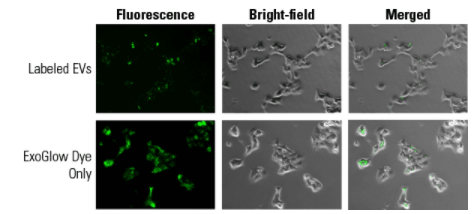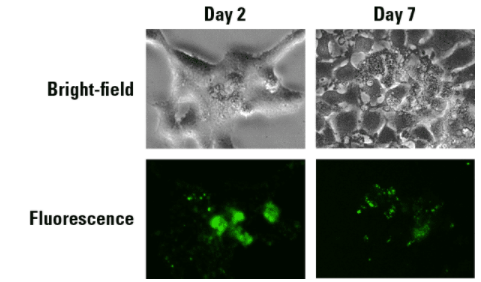System Biosciences
ExoGlow-Protein EV Labeling Kit (Red)
- SKU:
- EXOGP100A-1
- Availability:
- Usually Shipped in 5 Working Days
- Size:
- 20 reactions
- Shipping Temperature:
- Blue Ice
Description
ExoGlow-Protein EV Labeling Kit (Red) . Cat# EXOGP100A. Supplier: SBI System Biosciences

Overview
See EVs better with reagents specifically optimized for labelingSBI’s new generation of extracellular vesicle (EV) labeling reagents take your EV visualization to new levels of clarity, with low background and high selectivity. Unlike general-purpose labeling reagents that are not optimized for EVs and suffer from high levels of background signal, ExoGlow™-Protein Red improves your ability to track and localize EVs by specifically and covalently labeling internal EV proteins with a proprietary red fluorescent dye that delivers very low levels of background signal. The result is unmatched EV imaging for more accurate studies (see below for our full range of next generation ExoGlow reagents).
Emission: 588 nm
Laser line: 561 nm
Available next generation ExoGlow EV imaging reagents
- Specific—carefully developed to generate a robust signal specific for internal EV proteins, leading to very low levels of background
- Compatible—delivers robust performance on EVs isolated using all methods tested—including ExoQuick®, ultracentrifugation, and column-based workflows
- Easy-to-use—labeling protocol is quick and straightforward
- Powerful—can be used with as little as 200 µg of EVs
Emission: 588 nm
Laser line: 561 nm
Available next generation ExoGlow EV imaging reagents

Supporting Data
Imaging EVs with a new level of clarity
Imaging EVs with a new level of clarity

Figure 1. ExoGlow-Protein enables clear visualization of labeled EVs being internalized by target cells. We labeled HEK293T EVs with ExoGlow-Protein and followed uptake by HEK293T cells. The punctate fluorescence signal shows internalization of labeled EVs by the target cells.

Figure 2. Punctate staining pattern is EV-specific. The punctate staining pattern seen in Figure 1 and Panel A is due to ExoGlow-Protein-labeled EVs. When ExoGlow-Protein is added directly to target HEK203T cells (Panel B), only diffuse, non-specific staining is seen.

Figure 3. ExoGlow-Protein signal is stable for up to at least 7 days after administration of labeled EVs to cells.















